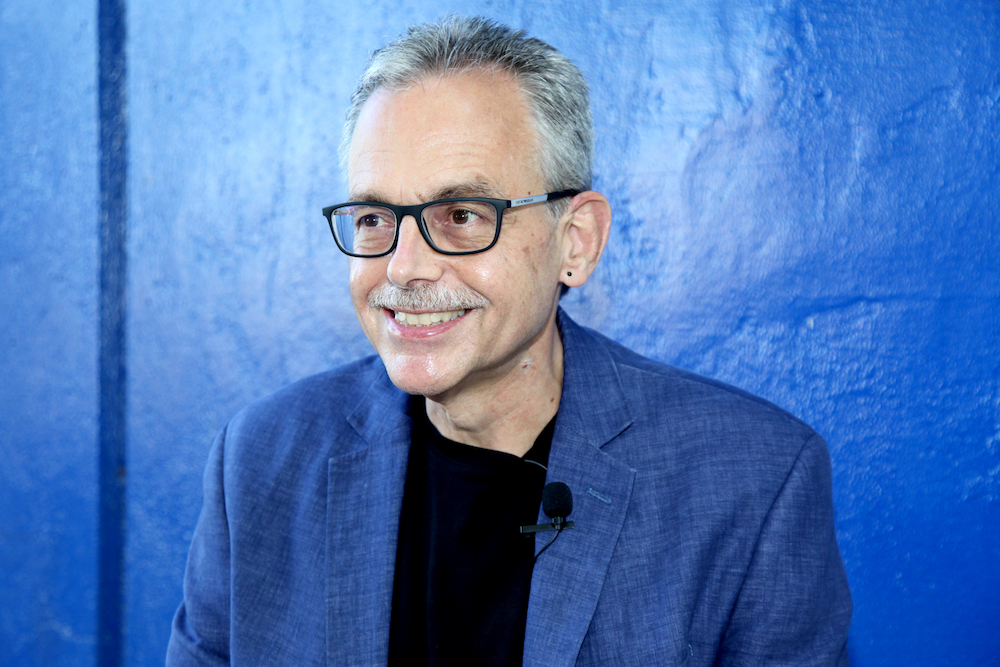
Photo by Aaron Salcido.
Manuel Pastor is a distinguished professor of sociology and American studies & ethnicity at the University of Southern California and co-author most recently of South Central Dreams: Finding Home and Building Community in South L.A. The inaugural holder of USC’s Turpanjian Chair in Civil Society and Social Change, he currently directs the Equity Research Institute (ERI) there as well. Before participating in the Zócalo/Esperanza Community Housing event “Is South L.A. Forging a New American Identity?,” Pastor chatted in the green room about his love for Echo Park, his collection of Skechers, and where he finds joy.
What is your favorite ice cream flavor?
It’s a bit of a disappointing answer. My favorite ice cream is having cantaloupe cut up with some other fruit. But I try to be supportive of other people when they go out for ice cream—and be supportive of people generally pursuing their dreams—in this case, ice cream.
You and your team conducted over 100 interviews for South Central Dreams; can you tell me about one conversation that altered your perspective in some way?
Erin Aubry Kaplan, an amazing chronicler of life in South L.A., whose father was a major organizer, building racial coalitions between Black, Latino, and Asian Pacific Islander communities. And her capacity to understand the nature of change in South Los Angeles, the need to build relationships between groups, and then also the sense of Black loss that’s going on there because of the demographic transformation, because of the gentrification and displacement pressures—her ability to articulate that was really tremendous.
You’re such a joyful person. Where do you think it comes from?
I am the son of an undocumented immigrant who’s now a full professor at the University of Southern California. That’s quite a journey. I started doing political work in the 1980s and early 1990s, when L.A. was being torn apart by divisions between the communities, and of course, the widening economic divides. And I have seen a city that’s been able to raise the minimum wage, able to address climate change, able to build bridges between Black and brown communities, able to shift from being a completely anti-labor city to being one of the leaders in labor organizing. I’ve seen a city that was xenophobic learn to welcome and celebrate immigrants. In the course of my lifetime, I’ve seen tremendous political change, and it brings me home, and it brings me to joy.
How did COVID change the way you dress?
I used to say that it was a good day pre-COVID when it was a Skechers day, meaning that I didn’t have to put on fancy shoes and long socks. Since COVID, it’s been a Skechers day, every day. So that’s my favorite accessory. I now have about 20 Skechers. I love the short socks. I love the comfort. These [Pastor gestures to the black shoes he is wearing for the event] are the fancy-ass Skechers.
What’s the last good book you read?
Relational Formations of Race: Theory, Method, and Practice. It’s the book that ended up framing our book. We were grappling with the story of Black-brown coalition building, and place identity, and all of a sudden there was this book that was entirely about relational racial formation. So rather than the way most people think about race, which is whites and people of color, it’s thinking about groups, and how they build relationships together.
Where’s your favorite place to go in L.A.?
My favorite place in L.A. is Echo Park, in particular, the corner of Echo Park that has the statue of José Martí. I’m Cuban American, but I grew up in L.A., and L.A. constantly surprises. To find a statue dedicated to José Martí in the corner of Echo Park, because there’s a Cuban American community there too—to be able to turn around from Echo Park and see downtown L.A., and the possibilities that are there—I think Echo Park is one of my favorite places.
One of my favorite views is over the 4th Street Bridge from East L.A. to downtown L.A. because what you realize is how close these two communities are, and yet how distinct they are. As a kid who grew up in L.A., downtown L.A. held such a sense of possibility, and that view from 4th Street Bridge services it.



